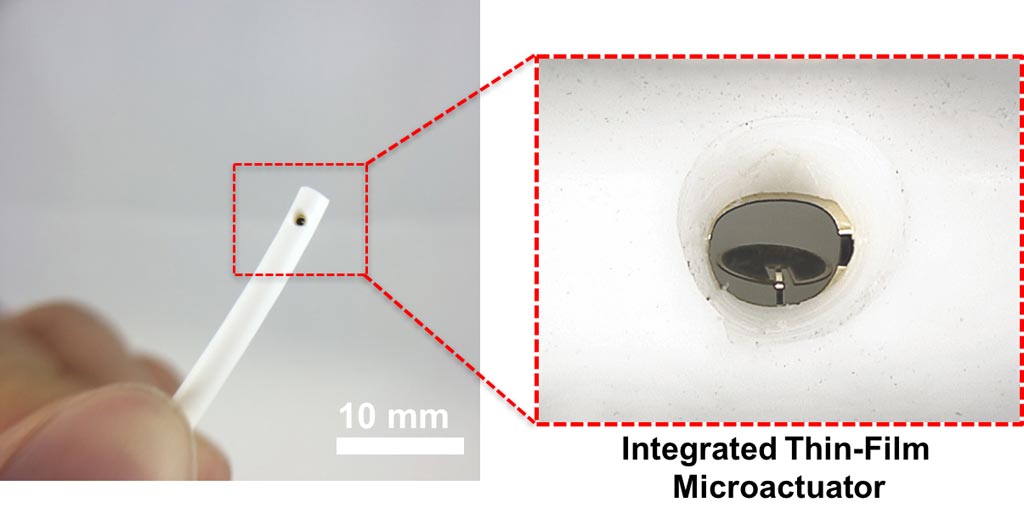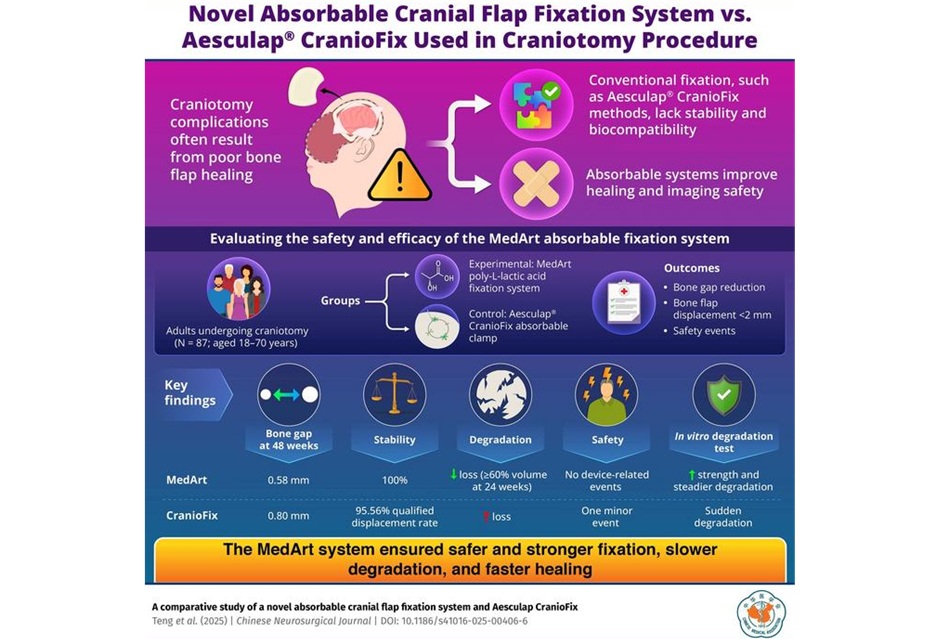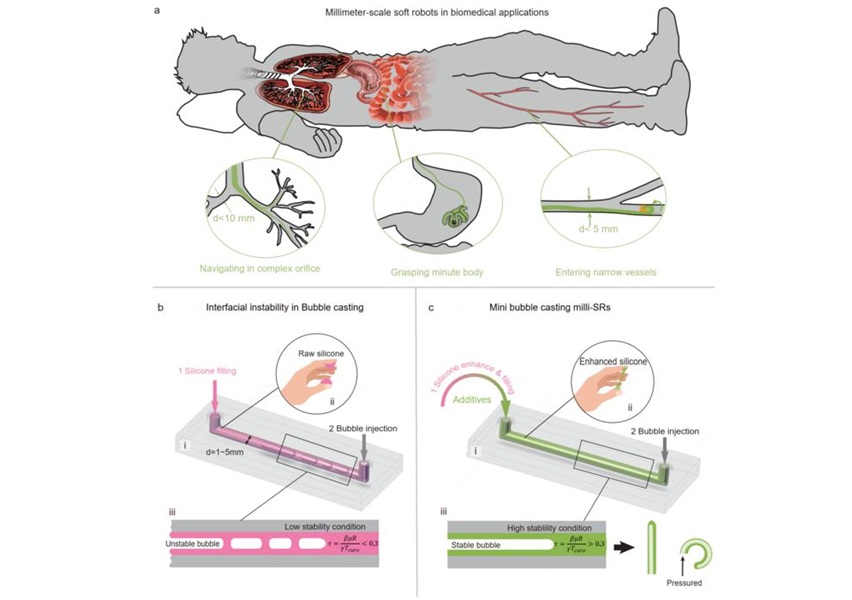Microscale Device Helps Keep Implantable Catheters Clear
|
By HospiMedica International staff writers Posted on 14 Jun 2017 |

Image: A new microscale device helps keep catheters clear (Photo courtesy of H Lee/ Purdue).
A new self-clearing technology could provide patients with neurological and other disorders reliable implantable catheters that could obviate additional surgery to replace failing devices.
Developed by researchers at Purdue University (Lafayette, IN, USA), the technology involves microscale devices with tiny magnetic elements that are located on a thin film that can be assembled into existing catheters. The micromechanical devices are subsequently activated by external magnetic forces in order to remove various biomaterials that foul the catheter. By using a time-varying magnetic field, changing its magnitude, or turning it on and off, dynamic movement and mechanical vibration are created at the pore to remove the obstructive biomaterials.
The magnetic approach generates a large amount of force, and can be done without an integrated circuit or power source, making it much simpler to implement and reducing the burden of hermetic packaging for the implantation process. Mechanical evaluations, including post-release deflection and static and dynamic responses of the device have thus far been tested in chronic shunt systems used for the treatment of hydrocephalus, which requires constant diversion of excess cerebrospinal fluid (CSF) from the brain.
“When a catheter is implanted, the body’s natural reaction is to protect itself against the foreign material by forming a sheath around it. Biofouling materials including bacteria, blood, and inflammatory cells, and other tissue quickly cover the device, often blocking the catheter’s inlet pores, leading to premature device failure,” said biomedical engineer Hyowon Lee, PhD, who developed the technology. “Approximately 40% of shunt systems fail within one year of implantation, and 85% fail within 10 years, mostly due to catheter obstruction.”
Hydrocephalus can cause an enlarged head in children and cause many other life-altering physical, behavioral, and cognitive symptoms in children and adults alike. Over one million people in the United States alone suffer from hydrocephalus, and one to two newborns develop the disorder every 1,000 births. Patients can also acquire hydrocephalus later on in life due to a traumatic brain injury (TBI) or hemorrhagic stroke. The shunt systems used to reduce CSF have a high fail rate due to biofouling, and replacing the failed catheter usually requires neurosurgery, with increased risk of infection and a huge economic, physical, and emotional burden for patients and their caretakers.
Related Links:
Purdue University
Developed by researchers at Purdue University (Lafayette, IN, USA), the technology involves microscale devices with tiny magnetic elements that are located on a thin film that can be assembled into existing catheters. The micromechanical devices are subsequently activated by external magnetic forces in order to remove various biomaterials that foul the catheter. By using a time-varying magnetic field, changing its magnitude, or turning it on and off, dynamic movement and mechanical vibration are created at the pore to remove the obstructive biomaterials.
The magnetic approach generates a large amount of force, and can be done without an integrated circuit or power source, making it much simpler to implement and reducing the burden of hermetic packaging for the implantation process. Mechanical evaluations, including post-release deflection and static and dynamic responses of the device have thus far been tested in chronic shunt systems used for the treatment of hydrocephalus, which requires constant diversion of excess cerebrospinal fluid (CSF) from the brain.
“When a catheter is implanted, the body’s natural reaction is to protect itself against the foreign material by forming a sheath around it. Biofouling materials including bacteria, blood, and inflammatory cells, and other tissue quickly cover the device, often blocking the catheter’s inlet pores, leading to premature device failure,” said biomedical engineer Hyowon Lee, PhD, who developed the technology. “Approximately 40% of shunt systems fail within one year of implantation, and 85% fail within 10 years, mostly due to catheter obstruction.”
Hydrocephalus can cause an enlarged head in children and cause many other life-altering physical, behavioral, and cognitive symptoms in children and adults alike. Over one million people in the United States alone suffer from hydrocephalus, and one to two newborns develop the disorder every 1,000 births. Patients can also acquire hydrocephalus later on in life due to a traumatic brain injury (TBI) or hemorrhagic stroke. The shunt systems used to reduce CSF have a high fail rate due to biofouling, and replacing the failed catheter usually requires neurosurgery, with increased risk of infection and a huge economic, physical, and emotional burden for patients and their caretakers.
Related Links:
Purdue University
Latest Critical Care News
- New Therapeutic Brain Implants to Eliminate Need for Surgery
- Stem Cell Patch Gently Heals Damaged Hearts Without Open-Heart Surgery
- Biomaterial Vaccines to Make Implanted Orthopedic Devices Safer
- Deep Learning Model Predicts Sepsis Patients Likely to Benefit from Steroid Treatment
- Programmable Drug-Delivery Patch Promotes Healing and Regrowth After Heart Attack
- Breakthrough Ultrasound Technology Measures Blood Viscosity in Real Time
- Magnetically Activated Microscopic Robotic Swarms Could Deliver Medicine Inside Body
- Frequent ECG Use Can Identify Young People at Risk of Cardiac Arrest
- Ultrasound Controlled Artificial Muscles Pave Way for Soft Robots
- AI-Powered Alerts Reduce Kidney Complications After Heart Surgery
- Algorithm Predicts and Lengthens Pacemaker Battery Life
- Novel Pill Could Mimic Health Benefits of Bariatric Surgery
- AI Models Identify Patient Groups at Risk of Being Mistreated in Hospital ED
- CPR Guidelines Updated for Pediatric and Neonatal Emergency Care and Resuscitation
- Ingestible Capsule Monitors Intestinal Inflammation
- Wireless Implantable Sensor Enables Continuous Endoleak Monitoring
Channels
Surgical Techniques
view channel
Magnetic Kidney Stone Retrieval Device Outperforms Ureteroscopic Laser Lithotripsy
Kidney stone disease affects millions worldwide and often requires ureteroscopic laser lithotripsy, yet fragment removal remains inefficient. Many patients are left with residual pieces that can cause... Read more
Absorbable Skull Device Could Replace Traditional Metal Implants Used After Brain Surgery
Closing the skull safely after neurosurgery remains a major clinical challenge, as traditional metal or semi-absorbable fixation devices can interfere with imaging, degrade unpredictably, or persist long... Read more
Magic Silicone Liquid Powered Robots Perform MIS in Narrow Cavities
Navigating the body’s smallest, tightest pathways has long restricted the reach of minimally invasive surgery. Traditional instruments struggle to access tunnels narrower than a grain of rice, limiting... Read more
'Lab-on-a-Scalpel' Provides Real-Time Surgical Insights for POC Diagnostics in OR
During surgery, waiting for laboratory test results can slow critical decision-making, especially in emergency or oncological procedures. Now, researchers have introduced a new diagnostic concept: a surgical... Read morePatient Care
view channel
Revolutionary Automatic IV-Line Flushing Device to Enhance Infusion Care
More than 80% of in-hospital patients receive intravenous (IV) therapy. Every dose of IV medicine delivered in a small volume (<250 mL) infusion bag should be followed by subsequent flushing to ensure... Read more
VR Training Tool Combats Contamination of Portable Medical Equipment
Healthcare-associated infections (HAIs) impact one in every 31 patients, cause nearly 100,000 deaths each year, and cost USD 28.4 billion in direct medical expenses. Notably, up to 75% of these infections... Read more
Portable Biosensor Platform to Reduce Hospital-Acquired Infections
Approximately 4 million patients in the European Union acquire healthcare-associated infections (HAIs) or nosocomial infections each year, with around 37,000 deaths directly resulting from these infections,... Read moreFirst-Of-Its-Kind Portable Germicidal Light Technology Disinfects High-Touch Clinical Surfaces in Seconds
Reducing healthcare-acquired infections (HAIs) remains a pressing issue within global healthcare systems. In the United States alone, 1.7 million patients contract HAIs annually, leading to approximately... Read moreHealth IT
view channel
Printable Molecule-Selective Nanoparticles Enable Mass Production of Wearable Biosensors
The future of medicine is likely to focus on the personalization of healthcare—understanding exactly what an individual requires and delivering the appropriate combination of nutrients, metabolites, and... Read moreBusiness
view channel
Philips and Masimo Partner to Advance Patient Monitoring Measurement Technologies
Royal Philips (Amsterdam, Netherlands) and Masimo (Irvine, California, USA) have renewed their multi-year strategic collaboration, combining Philips’ expertise in patient monitoring with Masimo’s noninvasive... Read more
B. Braun Acquires Digital Microsurgery Company True Digital Surgery
The high-end microsurgery market in neurosurgery, spine, and ENT is undergoing a significant transformation. Traditional analog microscopes are giving way to digital exoscopes, which provide improved visualization,... Read more
CMEF 2025 to Promote Holistic and High-Quality Development of Medical and Health Industry
The 92nd China International Medical Equipment Fair (CMEF 2025) Autumn Exhibition is scheduled to be held from September 26 to 29 at the China Import and Export Fair Complex (Canton Fair Complex) in Guangzhou.... Read more












